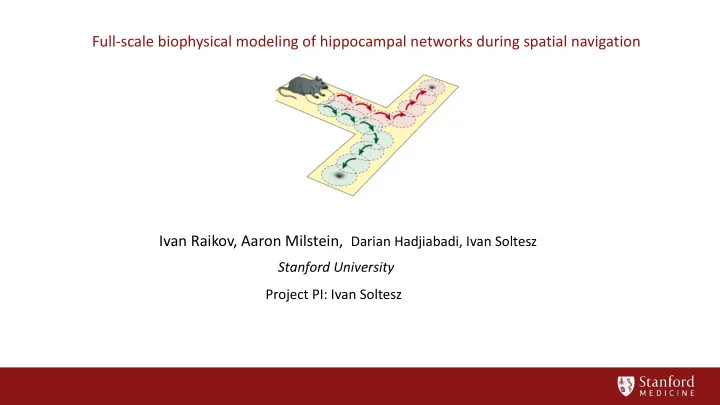

Full-scale biophysical modeling of hippocampal networks during spatial navigation Ivan Raikov, Aaron Milstein, Darian Hadjiabadi, Ivan Soltesz Stanford University Project PI: Ivan Soltesz
Introduction I use Blue Waters to construct, simulate and analyze full-scale biophysical computational models of the rodent hippocampus and understand the role of the neural circuitry in processing spatial information. - Full-scale : 1:1 correspondence between model neurons and biological system 6 10 (completed model will have approximately 2 x 10 neurons and 4 x 10 connections) - Biophysical : detailed neuronal morphology, synaptic connections, equations of ion channel and synapse currents (each model neuron can have thousands of state variables) - Hippocampus : part of the brain responsible for learning, memory, and spatial navigation
Introduction Yi et al., 2016
The brain’s navigational system
Cellular diversity and recurrent connectivity enable rhythm generation in a full scale model of CA1 Biological realism: High Intermediate Low Previous work Model: Bezaire, Raikov & Soltesz, 2016 Network configuration: CA1 # of principal cells >300,000 # of synapses / principal cell ~20,000 Cell excitability model Biophysical # of cell types 9 Cell-type-specific connectivity Distance-dependent Input pattern Constant Input strengths Equal Long-term plasticity None Network output: Rhythmicity Theta, gamma, ripple Output selectivity None Output fraction active (%) ~100% Key insight: Cellular and circuit mechanisms of rhythm generation Bezaire, M. J., Raikov, I., Burk, K., Vyas, D., & Soltesz, I. eLife , 2016. 5
Diversity of information representation in the hippocampus and cortex • neuronal sequences are organized internally and do not require sensory inputs or motor outputs • the internally organized sequences can represent spatial and temporal information and planned behaviors corresponding to the near future. • The aim of this project is to decipher the cellular and network mechanisms of the formation of population activity sequences that represent spatiotemporal information. Fujisawa et al., 2017 6
Topographical connectivity in the hippocampus Harland, Contreras and Fellous, 2017 7
Large-scale biophysical model of spatial coding in the hippocampal dentate gyrus * In progress Biological realism: High Intermediate Low Previous work Model: Raikov, Milstein & Soltesz Network configuration: DG # of principal cells 1,000,000 # of synapses / principal cell ~10,000 Cell excitability model Biophysical # of cell types 9 Cell-type-specific connectivity Distance-dependent Input pattern Selective (grid + place) Input strengths * History-dependent Long-term plasticity None Network output: Theta, gamma Rhythmicity * Realistic anatomical Output selectivity gradient of field widths * <2% GC, >15% MC Output fraction active (%) Key insight: Role of feedback excitation from mossy cells in regulating sparsity and selectivity in the dentate gyrus. Raikov, I., Milstein, A. D., Ng G., Hadjiabadi, D. & Soltesz, I. Unpublished , 2019. 8
Realistic geometry in a full-scale model of the dentate gyrus Schneider et al., PloS Comp Biol , 2014
large-scale biophysical model of the hippocampal dentate gyrus Raikov, I., Milstein, A. D., Ng G., Hadjiabadi, D. & Soltesz, I. Unpublished , 2019. 10
Spatial selectivity and sparsity of dentate gyrus model Raikov, I., Milstein, A. D., Ng G., Hadjiabadi, D. & Soltesz, I. Unpublished , 2019. 11
Spatial selectivity and sparsity of dentate gyrus model Raikov, I., Milstein, A. D., Ng G., Hadjiabadi, D. & Soltesz, I. Unpublished , 2019. 12
Spatial selectivity and sparsity of dentate gyrus model 13
Spatial selectivity and sparsity of dentate gyrus model MPP GC Raikov, I., Milstein, A. D., Ng G., Hadjiabadi, D. & Soltesz, I. Unpublished , 2019. 14
Testing a theory for hippocampal interactions in sequence generation Lisman, J. E., Talamini, L. M., & Raffone, A. Neural Networks , 2005. 15
Conclusions Simulation run time on Blue Waters - We have made significant progress developing a full-scale, Model Number Simulated Run time biophysical model of the rodent hippocampus of Nodes time Dentate 2048 10 s 7.5 hours - Model comprised of realistically diverse cell types, cell-type- gyrus specific connectivity, realistic anatomical distribution of cells, and non-uniform distributions of synaptic input strengths Dentate 4096 10 s 6.1 hours gyrus - The dentate gyrus (DG) model generates sparse, selective, and sequential population activity that matches in vivo experimental CA1 1024 10 s 12.8 data hours - Prototype to develop general software infrastructure to specify, CA1 2048 10 s 6.2 hours simulate, optimize, and analyze large-scale biophysically- detailed neuronal network models - Scalable across tens of thousands of processors on Blue Waters 16
Acknowledgments External Soltesz lab members: collaborators: Aaron Milstein Grace Ng Cesar Renno-Costa Sarah Tran (Digital Metropolis Darian Hadjiabadi Institute, Brazil) Raymond Liou Sandro Romani (Janelia) 17
Recommend
More recommend